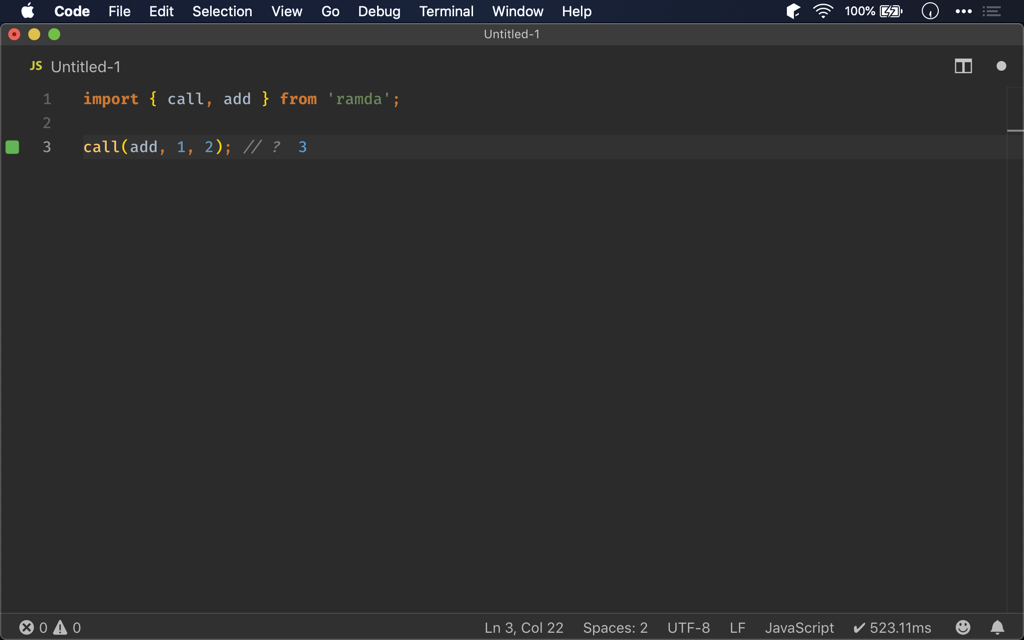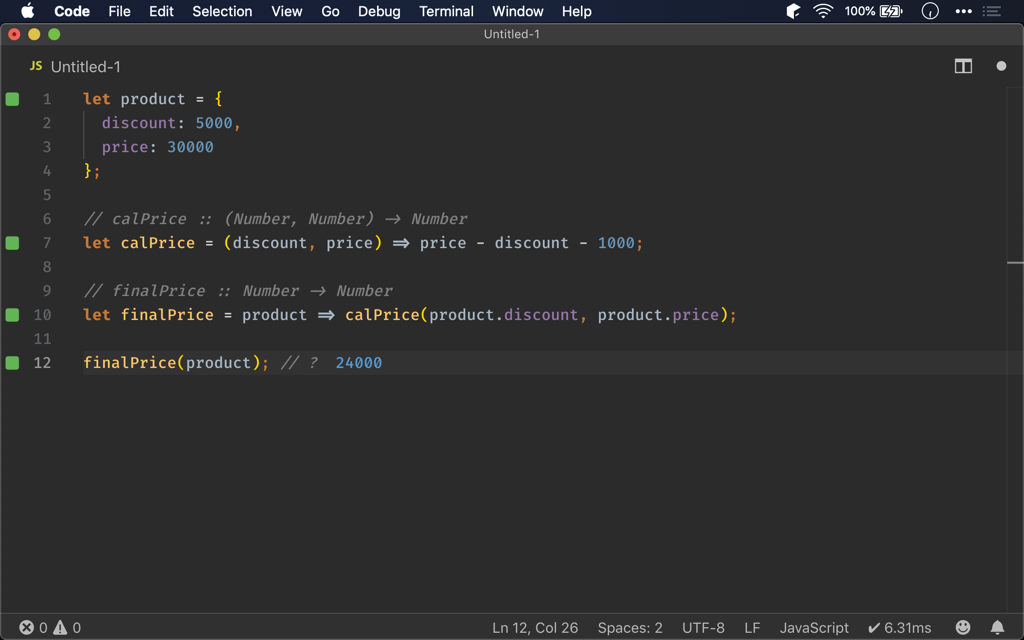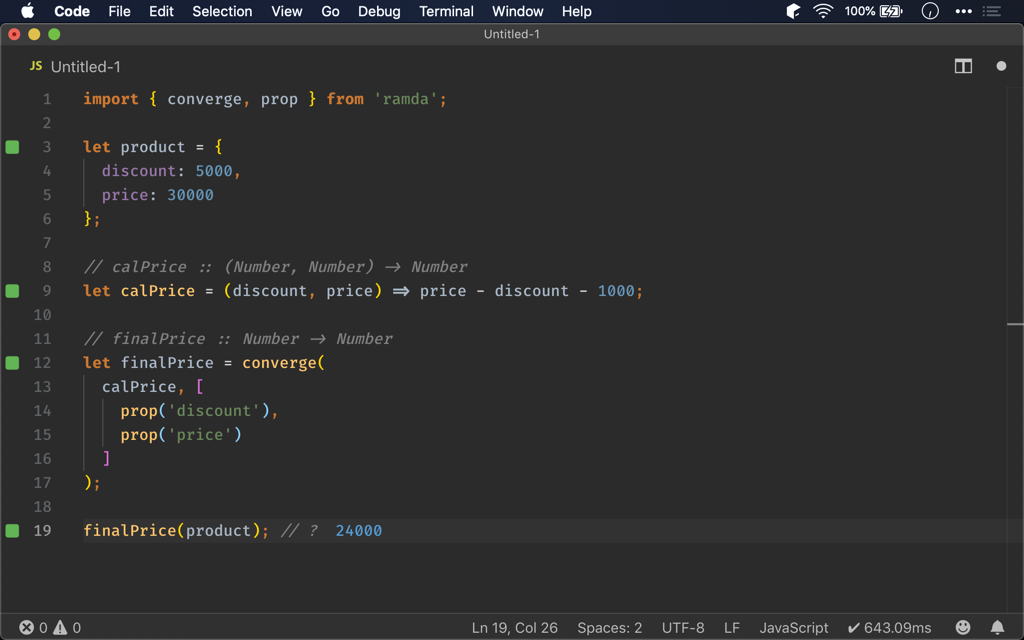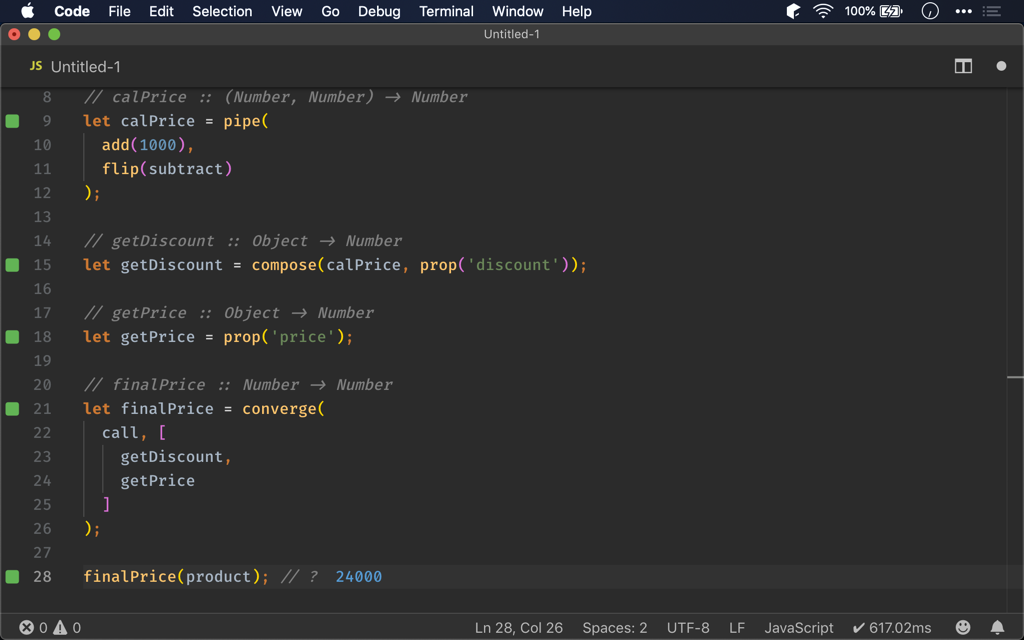Ramda 的 call() 乍看很不起眼,但若搭配 converge() 之後,就能動態產生 Converging Function。
Version
macOS Mojave 10.14.5
VS Code 1.32.3
Quokka 1.0.195
Ramda 0.26.1
call()
import { call, add } from 'ramda';
call(add, 1, 2); // ?
最簡單的 call(),第一個 argument 為 function,第二個 argument 之後為該 function 的 argument list,相當於執行 add(1, 2)。
call()
(*… → a),*… → a
執行第一個 argument 的 function,並將之後 argument 當作該 function 的 argument list
(*… → a):任意 function
*… :任意 argument list
a:回傳 function 執行的結果

Function
let product = {
discount: 5000,
price: 30000
};
// calPrice :: (Number, Number) -> Number
let calPrice = (discount, price) => price - discount - 1000;
// finalPrice :: Number -> Number
let finalPrice = product => calPrice(product.discount, product.price);
finalPrice(product); // ?
calPrice() 傳入 discount 與 price argument,會計算出折扣後價錢。
fn() 則傳入 product object,再呼叫 calPrice()。

Point-free
import { converge, prop } from 'ramda';
let product = {
discount: 5000,
price: 30000
};
// calPrice :: (Number, Number) -> Number
let calPrice = (discount, price) => price - discount - 1000;
// finalPrice :: Number -> Number
let finalPrice = converge(
calPrice, [
prop('discount'),
prop('price')
]
);
finalPrice(product); // ?
首先將 finalPrice() point-free。
11 行
// finalPrice :: Number -> Number
let finalPrice = converge(
calPrice, [
prop('discount'),
prop('price')
]
);
finalPrice() 的 argument 為 product object,包含 discount 與 price property,分別傳入 折扣 與 價錢。
最後要執行的是 calPrice(),分別有 discount 與 price 兩個 argument。
由於傳入 finalPrice() 的是 object,因此勢必要先使用 prop() 拆解後才能傳給 calPrice() 執行。
這正是使用 finalPrice() 時機,將 calPrice() 當作 converging function,將 prop() 當作 branching function。
就功能而言沒問題,唯 calPrice() 並非 point-free,是否有繼續優化空間呢 ?

import { converge, prop, call, add, pipe, subtract, flip, compose } from 'ramda';
let product = {
discount: 5000,
price: 30000
};
// calPrice :: (Number, Number) -> Number
let calPrice = pipe(
add(1000),
flip(subtract)
);
// getDiscount :: Object -> Number
let getDiscount = compose(calPrice, prop('discount'));
// getPrice :: Object -> Number
let getPrice = prop('price');
// finalPrice :: Number -> Number
let finalPrice = converge(
call, [
getDiscount,
getPrice
]
);
finalPrice(product); // ?
由於 calPrice() 有兩個 argument:discount 與 price,基於 currying 特性,可將 calPrice() 視為由 discount 產生的 function,其 argument 只剩下 price。
第 8 行
// calPrice :: (Number, Number) -> Number
let calPrice = pipe(
add(1000),
flip(subtract)
);
calPrice() 最直覺會想用 pipe(),多減 1000 元就相當於 discount 多加 1000 元,所以先套用 add(1000) 將 discount 加 1000,再傳到下一個 subtract()。
但 subtract() 第一個 argument 為 被減數,而 add(1000) 為 減數,因此必須使用 flip() 將 subtract() 的 signature 反轉後才能使用。
我們發現 calPrice() 已經 point-free 了。
21 行
// finalPrice :: Number -> Number
let finalPrice = converge(
call, [
getDiscount,
getPrice
]
);
由於 calPrice() 由 discount 產生,因此 converge() 的 converging function 就不能再是 calPrice(),而要改用 call(),如此才會執行第一個 branching function。
第一個 branching function getDiscount() 以取得 discount 為目標。
第二個 branching function getPrice() 以取得 price 為目標,再傳入第一個 branching function 執行,這是因為 call() 的緣故。
14 行
// getDiscount :: Object -> Number
let getDiscount = compose(calPrice, prop('discount'));
從 object 取得 discount property,然後透過 calPrice() 計算。
17 行
// getPrice :: Object -> Number
let getPrice = prop('price');
從 object 取得 price property。

Conclusion
- 當 converging function 並非固定,而是由其他 function 動態產生時,可搭配
call(),使其在 branching function 先動態產生 function,再由call()呼叫執行之
Reference
Ramda, call()
Ramda, add()
Ramda, converge()
Ramda, add()
Ramda, pipe()
Ramda, subtract()
Ramda, flip()